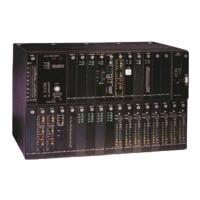Chapter 1. System Overview and Modes of Operation
2
D/I Mux III Functions
The D/I Mux III can be configured to communicate over T1-1 or T1-2 (up or down the T1 span), or over
both. As a drop-and-insert system, the D/I Mux III drops (extracts and distributes) the channel contents
from either or both of the T1 Receive (Rx) signals, and makes them available to external devices. It then
inserts (picks up and adds) the channel contents from these devices to either or both of the T1 Transmit
(Tx) signals.
The D/I Mux III provides an economical means of connecting to remote external devices such as
telephones, modems, computers, terminal controllers, PBX units, etc. The D/I Mux III, in all modes of
operation, supports local and remote control functions, networking management, transmission quality,
and failure protection.
D/I Mux III Features
A D/I Mux III system includes the following features:
• A multi-tasking microprocessor for rapid reconfiguration and quick response to changing network
conditions
• Software control and configuration
• Automatic alarm notification
• Eight preconfigured maps for easy reconfiguration of the DS0 transmission channels
• Time, event, manual, and alarm control of maps (alarm map control requires Feature Group X.4 or
higher)
• Selectable timing sources
• Real-time alarm reporting and recording
• Alarm LED indicators
• External alarm contacts
• T1 equalization
• Optional T1 test jacks
• Lightning protection
• AC or DC power supplies
• Optional redundant DC power supplies
• Internal ringing generator (with AC power supply systems)
• Voice, data, and subrate data circuits
• High fidelity audio circuits
• Circuit level loopbacks and testing
• Optional integrated Channel Service Unit (CSU)
• Optional Simple Network Management Protocol (SNMP) to streamline network management
• With SNMP, Serial Line Internet Protocol (SLIP) feature allowing communication between network
manager and a far-end D/I Mux that is not connected directly via a LAN, or router
• With SNMP, a gateway feature enabling message transfer between different networks
• With AIM-Net, a network management system

